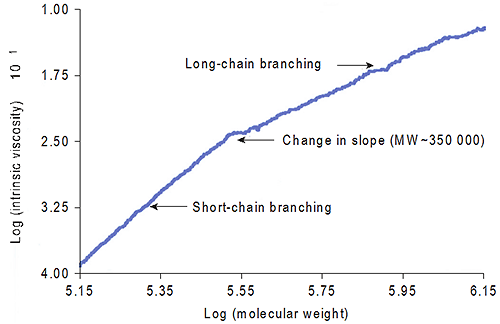Gel permeation chromatography (GPC) is an established method of determining the molecular mass of polymers. GPC is a fractionation technique so it determines not merely the average values but the complete distribution of molecular weights. However, in its conventional form, (i.e.,using a single concentration detector), GPC only gives relative molecular masses. To overcome this limitation and meet the growing demand for the characterization of increasingly complex polymers, detectors sensitive to molecular weight, such as light scattering detector and viscometer, can be used in GPC. In this way, absolute molecular weight distributions can be obtained, as well as distributions of molecular weight and viscosity. Armed with these, the Mark-Houwink plot can be constructed giving further structural information, such as the degree of polymer branching.
In GPC molecules are separated according to their hydrodynamic volume. Their molecular weights (MW) and molecular weight distribution can be determined from the measured retention volume (RV) by means of a calibration curve (log MW against RV),which must be set up with the aid of a number of standards of known molecular weight. But, as the relationship between molecular weight and size depends on the type of polymer, the calibration curve depends on the polymer used, with the result that true molecular masses can only be obtained if the calibration standards and the sample are of the same type. In all other instances, the results are only relative. Large deviations from the true molecular weight occur in the instance of branched samples, in particular, because the molecular density of these is substantially higher than in linear chains (1, 2). For conventional GPC the detectors used are either refractive index (RI) or ultraviolet (UV) detectors. Their signals depend solely on concentration, not on molecular weight or polymer size.
Today, viscosity and/or light scattering detectors are very often used to overcome the limitations of conventional GPC. These mass sensitive detectors are providing complementary information.
The signal of light scattering detectors are directly proportional to the molecular weights of the polymers, the concentration and dn/dc value squared. Since the dependance on the refractive index increment, dn/dc is squared it results that any inaccuracy in this value leads to very large deviations in molecular weight. Whether or not light scattering detectors can be used depends decisively on the refractive index increment of the polymer solvent combination. Where values are high, useable signals are obtained down to molecular masses of approximately 1000 g/mol. In the situation of other polymers, such as polylactide in THF (dn/dc = 0.049), the size of the signal is only about 7% of the polystyrene in THF signal at the same concentration and molecular weight, making reliable evaluation at low MW more challenging. The advantage of light scattering in GPC is that, once calibrated, molecular weight can be directly determined without a calibration curve provided that the signal-to-noise ratio is adequate.
With regard to viscosity detectors, the signal is proportional to the intrinsic viscosity (IV or [η]) and the concentration of the polymer. For low molecular weights, the sensitivity of the viscosity detector exceeds that of light scattering, even at high dn/dc (see Figure 1). This means that true molecular weights can be obtained, by means of universal calibration, even for samples where the signal-to-noise ratio of light scattering is inadequate.

|
The well-known Mark-Houwink plot is obtained by means of the double logarithmic plot of intrinsic viscosity against MW. It is the central plot of polymer structure analysis as it reflects structural changes in the polymer such as branching and chain rigidity. The slope, described by the Mark-Houwink exponent can vary between 0 for solid spheres and 2 for rod-shaped structures (3).
Combining the advantages of both detectors leads to triple detection (RI/viscosity/LS). Molecular masses can be determined by light scattering, and structure information through intrinsic viscosity. In addition, this combination makes it possible to determine and differentiate between aggregates and microgels. To analyse low MW and/or low dn/dc polymers, universal calibration can be used without the need to convert the GPC system.
It is advantageous to use light scattering to determine molecular weights provided the signals are sufficiently intensive strong. Triple detection combines these detection capabilities in to a single system to give molecular weight and structure without limitations.

|
W.W. Yau, J.J. Kirkland and D.D. Bly, Modern Size Exclusion Liquid Chromatography, (Wiley and Sons, New York, USA, 1979).
S. Mori and H.G. Barth, Size Exclusion Chromatography, (Springer-Verlag Berlin, Heidelberg, Germany, 1999).
H.-G. Elias, Makromoleküle, 5th Edition,(Hüthig & Wepf, Basel, Switzerland, 1984).